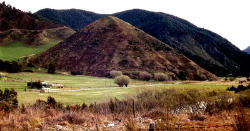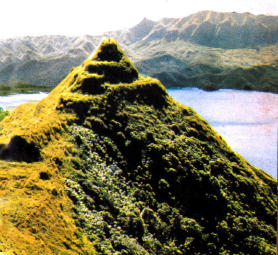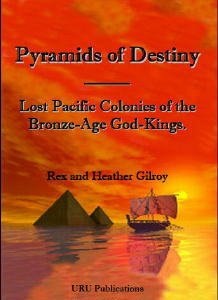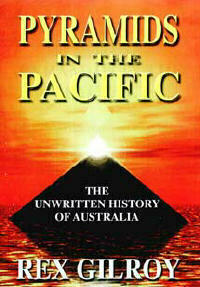
| Pyramids of Destiny – Lost Pacific Colonies of the Bronze-Age God-Kings |
 |
The Central Pacific Island of Rapaiti contains evidence of occupation by a past culture in the form of ancient Mesopotamian terraced ziggurat type pyramids.
These structures form part of a ghostly chain extending from ancient Mesopotamia down through Australia and beyond to Easter Island.
|
Pyramids of Destiny – Lost Pacific Colonies of the Bronze-Age God-Kings
by Rex & Heather Gilroy
Copyright
© Rex Gilroy 2009
| “Australian history is almost always picturesque; indeed it is so curious and strange, that it is itself the chiefest novelty the country has to offer, and so it pushes all other novelties into second and third place. It does not read like history but like the most beautiful lies. Mark Twain: Following the Equator [1891] |
”Every truth passes through three stages before it is recognised. In the first, it is ridiculed. In the second, it is opposed. In the third, it is regarded as self evident.” Arthur Schopenhauer [1788-1860] |
Part Two.
Old World Voyages to Australantis.
Chapter Eight.
Indo-Aryans and the Treasures of Paradise.
The historical information in this chapter comes from the authors book “Pyramids in the Pacific – the Unwritten History of Australia, [URU Publications 2000]. The Tamil Bell relic described is now displayed in Te Papa Museum, Wellington, New Zealand.After Uru and Sumer, India was the home of one of the worlds’ most ancient civilisations, with a written history which scholars date back 4,000 years. India’s earliest known civilised society began in the Valley of the Indus River, which lies between Pakistan and north-west India. Now largely arid, in antiquity it was jungle and marsh covered country.
Migrating dark-skinned people from the mountainous areas of Iran, who had contact with the people of Mesopotamia, entered the region around 4000 BC to establish farming communities which grew into cities. The Indus people manufactured mud bricks with which they constructed better dwellings that resisted the yearly floods.
They also developed many other skills in soil cultivation, tanning leather, garment weaving and the manufacturing of pottery and furniture. By 2000 BC their cities had grown around the coast of the Arabian Sea, extending from the Iranian border eastwards and southwards to the region of modern Bombay, and in a broad area stretching far northwards across the flood plain of the Indus Valley.
The people of the Indus civilisation developed well-organised governments and a form of picture writing [yet to be deciphered]. Their civilisation possessed many Mesopotamian features with an organised religion. They manufactured copper tools and shared the wheeled cart with Mesopotamia, and made jewellery equal to any elsewhere at that time.
These people and their culture are identified as the Harappan Civilisation, 100 sites are known to archaeologists, two of these were large cities – Harappa and Mohenjo-Daro. Several other sites were large towns, and the rest were small villages. It is estimated that Harappa and Mohenjo-Daro each supported populations of up to 40,000 people with a busy commercial life. Many materials had to be imported, particularly metals.
Their nearest source of silver, lead and gold came from Afghanistan where they also obtained lapis lazuli. Here they also obtained copper, as well as from Rajasthan, not far from the Indus Valley. They obtained jadeite from northern Burma and Tibet, and from Iran [via northern India] and further west, turquoise and tin. They produced bronze tools and weapons and traded with Mesopotamia, especially Ur.
They developed single-sailed wooden ships which ventured farther afield than is often believed, for there is evidence that Indus crews reached remote lands beyond the Indian Ocean. Comparisons have been drawn between the Indus and the mystery script of Easter Island, and other similar inscriptions found upon rocks in Brazil and Australia.
Their ships returned home with copper, ivory and wood from Oman on the Persian Gulf. But Indus crews must have reached Ceylon [ancient Lanka] and other south-east Asian islands on their way into the Pacific Ocean [as suggested by the Australian rock inscriptions], and vessels sailing between the Indus and south-east Asian ports, might have occasionally been blown off course to find our shores, as were Phoenicians, Egyptians and others throughout the ages.
As the name ‘Uru’ was known throughout the Indian sub-continent and Mesopotamian, the Harappans must already have had knowledge of Australia.
The Harappans were worshippers of a horned fertility God that resembled Shiva, one of the most prominent of all Hindu deities, figurines of the Gods and Goddesses recovered from their ancient settlements show close similarities with those of Hindu deities today; thus the Harappans had an influence upon the Hindu religion.
The Indus Valley Civilisation collapsed around 1500 BC, overwhelmed by invaders from northern Iran and beyond – the Aryans.The Aryans drove the Harappans out of the Indus Valley, forcing them to spread out across northern India as far as the southern region of the Indian peninsula. Here they settled to become the modern-day Southern Indians.
The founders of the Indo-Aryan Civilisation were originally wandering cattle-raising tribes in search of new pasturelands. They were a pale-skinned rugged, war-like people who for many centuries were not skilled artisans and also lacked a written language. Their foremost deity was Indra, their God of War.
Main Book Index | Mysterious Australia Homepage | URU Homepage | Australian Yowie Research Centre

